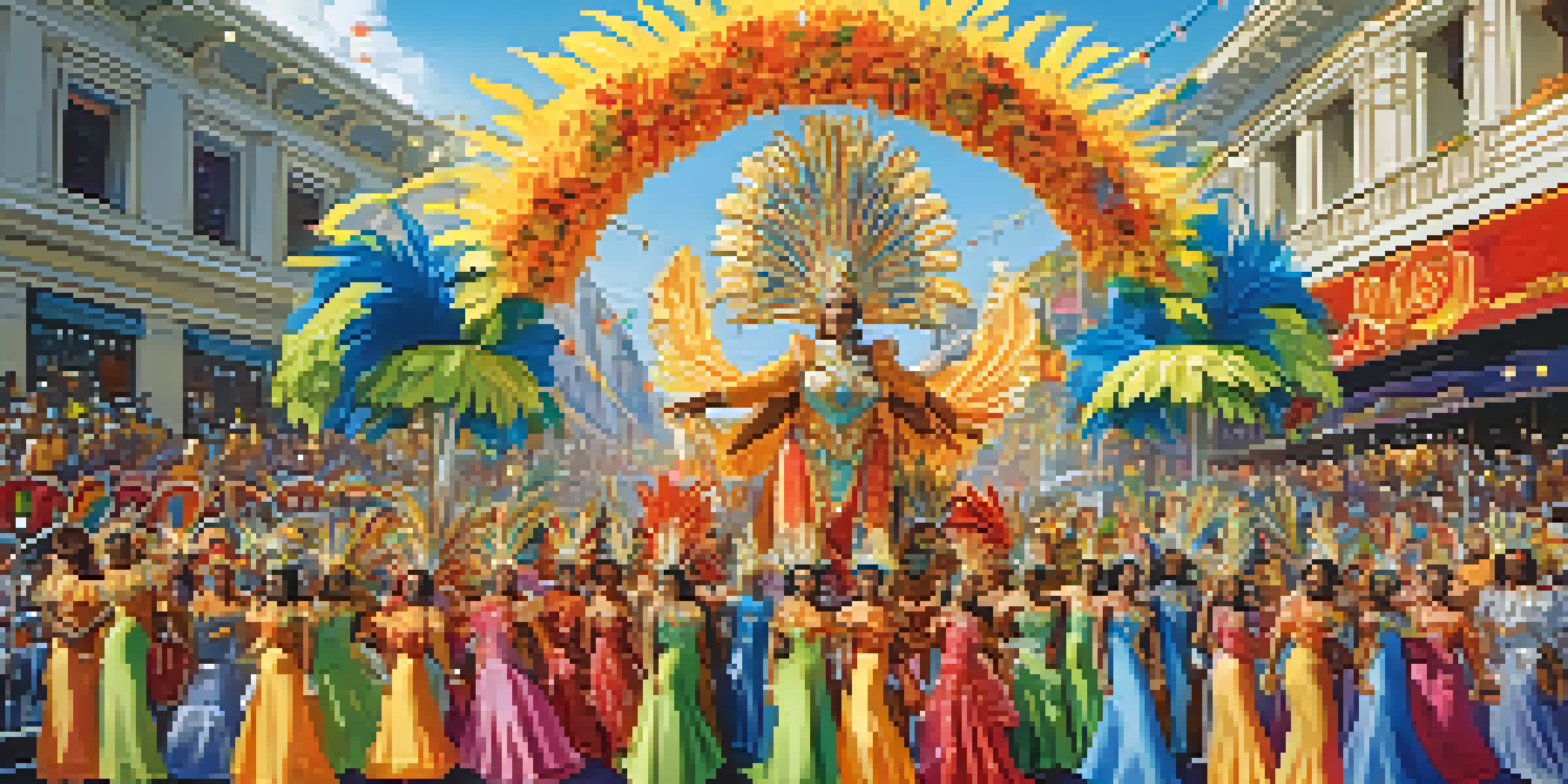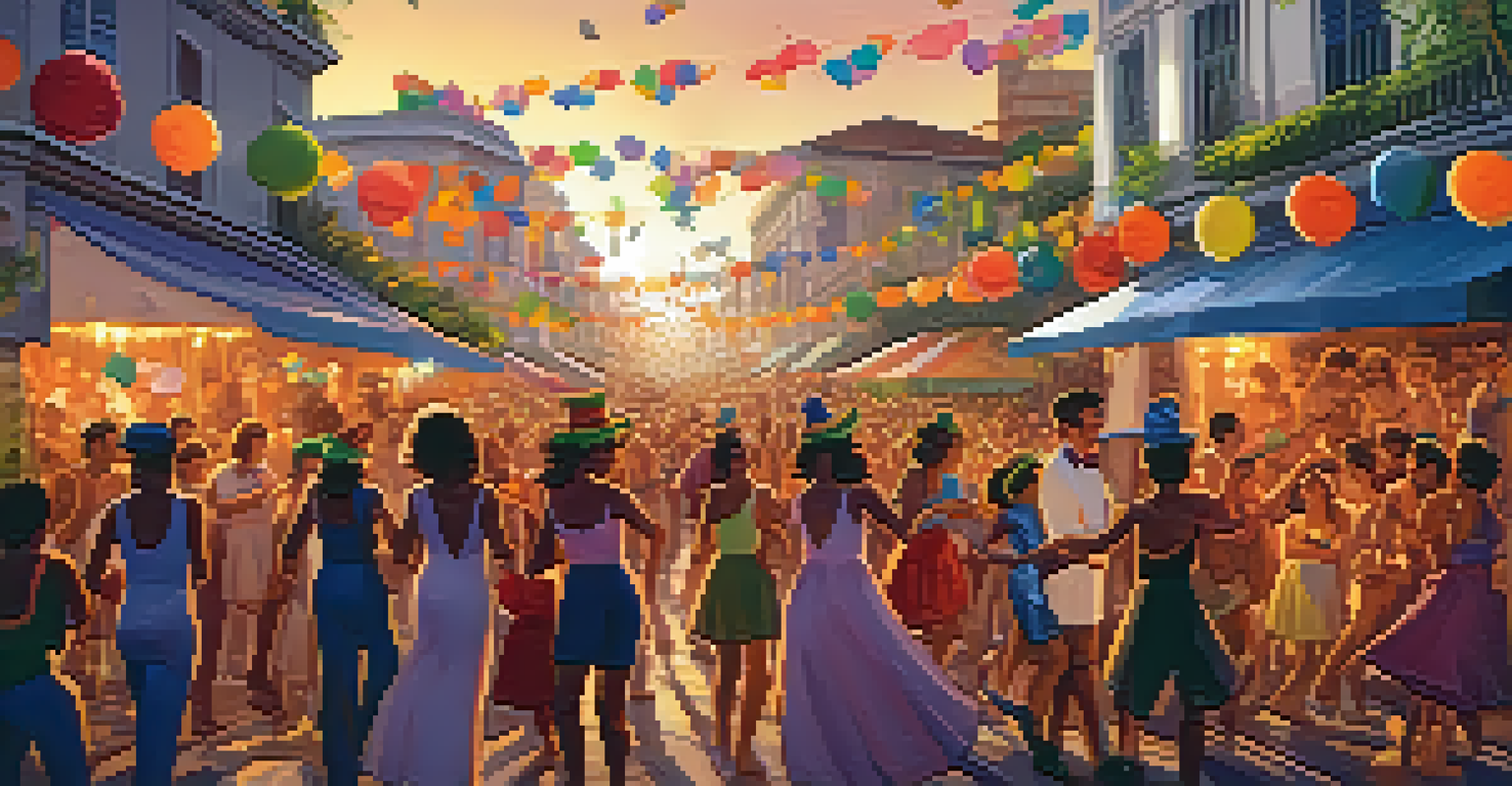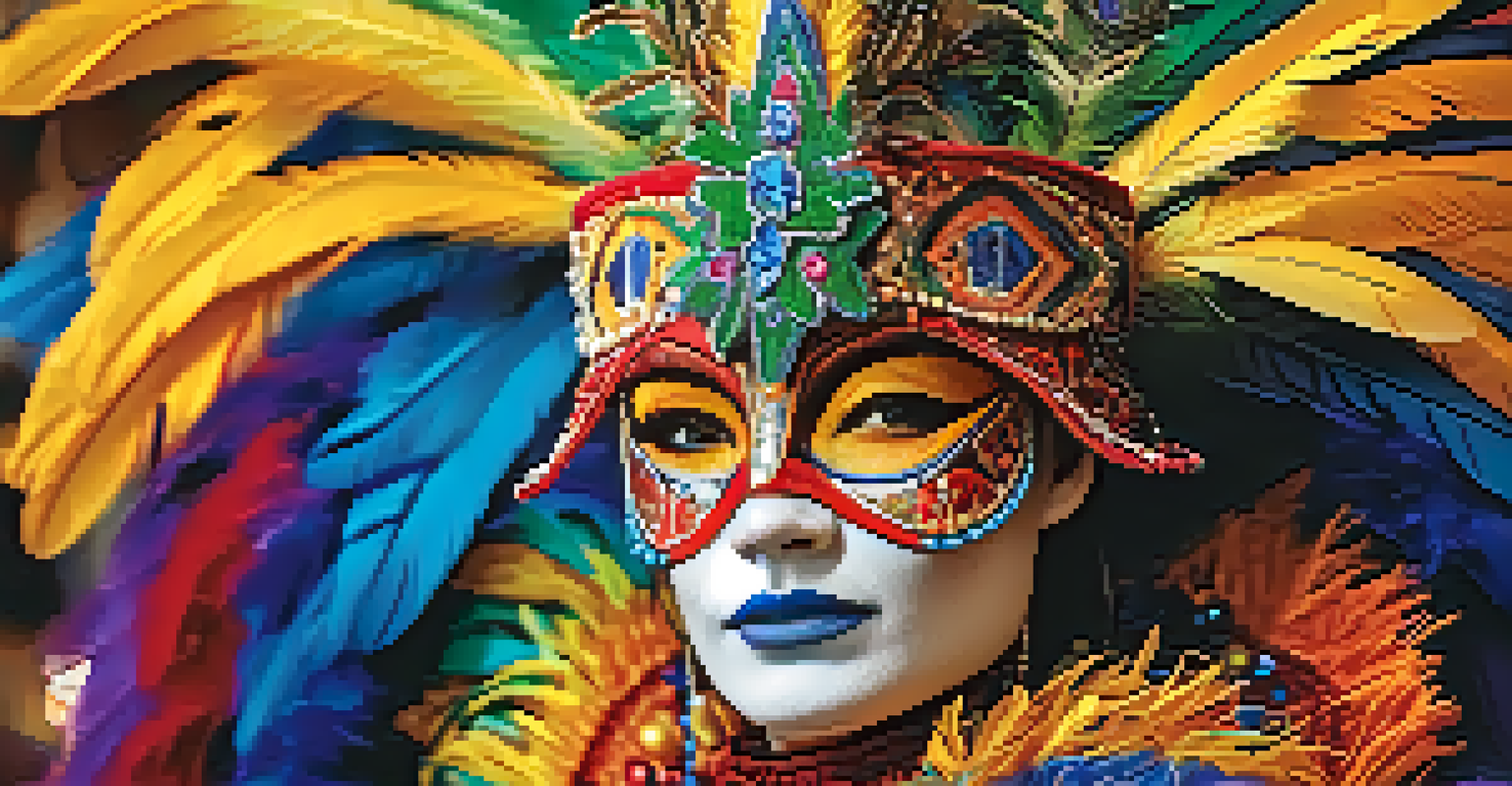Rio's Carnival Experience: Urban Festivities and Traditions

The Origins of Rio's Carnival: A Cultural Mosaic
Rio's Carnival is rooted in a rich tapestry of cultural influences, blending Portuguese, African, and indigenous traditions. This fusion began in the 18th century as a pre-Lenten celebration that evolved into the vibrant spectacle we know today. Each year, millions gather to celebrate this unique heritage, creating a sense of community and belonging.
Carnival is the time when the world turns upside down, and the joyous expression of culture bursts forth.
The early festivities featured small gatherings with music and dance, but over time, they transformed into grand parades filled with elaborate floats and costumes. The influence of African rhythms introduced samba, which has become the heartbeat of the Carnival. This evolution showcases how traditions can adapt while still honoring their origins.
As Carnival approaches, the streets of Rio come alive with rehearsals and community events, signaling the excitement that builds over the months. Local samba schools play a crucial role, fostering creativity and unity as they prepare for the grand parade. This sense of collaboration enriches the Carnival experience, making it a celebration of both individual and collective identity.
The Vibrant Parades: A Feast for the Senses
At the heart of Rio's Carnival are the spectacular parades held at the Sambadrome, where samba schools compete for glory. These performances are a breathtaking display of creativity, featuring intricate costumes, impressive floats, and captivating dance routines. Each school tells a story through their performance, often reflecting social issues or historical themes.

The atmosphere during the parades is electric, with thousands of spectators cheering, dancing, and joining in the festivities. The rhythmic beats of samba music echo throughout the venue, drawing everyone into the celebration. It’s a true feast for the senses, where colors, sounds, and emotions blend into one unforgettable experience.
Cultural Roots of Carnival
Rio's Carnival is a vibrant celebration that blends Portuguese, African, and indigenous traditions, showcasing a rich cultural heritage.
Participating in these parades isn’t just for the samba schools; anyone can join in the fun! Many locals and tourists dress up in costumes and dance alongside the performers, creating a shared sense of joy and community. This inclusivity is what makes Rio's Carnival a unique and cherished tradition.
Street Parties: The Pulse of Carnival Culture
While the parades are iconic, the real heart of Rio's Carnival can be found in its street parties, known as 'blocos.' These spontaneous gatherings pop up all over the city, inviting everyone to join in the revelry. Each bloco has its own theme and musical style, offering a diverse range of experiences for participants.
In every community, there is work to be done. In every nation, there are wounds to heal. In every nation, there is greatness.
The atmosphere at a bloco is informal and festive, with people of all ages dancing, singing, and celebrating together. Participants often dress in colorful outfits or themed costumes, adding to the vibrant street scene. It's a wonderful opportunity to meet new friends and embrace the spirit of Carnival in a more laid-back environment.
These street parties also highlight the importance of local traditions and community involvement. Many blocos are organized by residents who want to share their culture and bring people together. This grassroots approach to celebration emphasizes the idea that Carnival is not just an event but a shared experience that strengthens bonds among participants.
Costumes and Creativity: The Art of Carnival Attire
Costumes play a pivotal role in Rio's Carnival, showcasing the creativity and artistry of its participants. Each samba school invests significant time and resources into designing costumes that reflect their theme, often using vibrant colors and elaborate designs. This focus on costume-making transforms the parade into a visual spectacle that captivates audiences.
Traditionally, these costumes are handmade, involving skilled artisans and community members. The process of creating these outfits is as much a part of Carnival as the celebration itself, fostering collaboration and craftsmanship. Many participants also create their own costumes, allowing for personal expression and creativity.
Samba: The Soul of the Celebration
Samba music, with its infectious rhythms, serves as the heartbeat of Rio's Carnival, fostering unity and joy among participants.
Wearing a unique costume during Carnival is a rite of passage for many locals and visitors alike. It adds to the overall experience, as people feel a sense of belonging and pride in their attire. This emphasis on individuality within a collective celebration illustrates the heart of Rio's Carnival—a joyous expression of culture and community.
Music: The Heartbeat of Rio's Carnival
No discussion of Rio's Carnival would be complete without mentioning the music that drives the festivities. Samba, with its infectious rhythms and lively beats, is the genre synonymous with Carnival. Its origins can be traced back to African musical traditions, and it has since evolved to become the soundtrack of the celebration.
Throughout the Carnival season, samba music fills the air, from the grand parades to the street parties. Local musicians often participate in impromptu jam sessions, inviting everyone to join in the fun. This communal spirit fosters a sense of unity, as people come together to dance and celebrate, regardless of their background.
In addition to samba, other genres like funk, mpb (música popular brasileira), and even international music styles are incorporated into the Carnival experience. This blend of sounds reflects Rio's diverse culture and ensures that there’s something for everyone to enjoy. The music of Carnival is more than just entertainment; it's a vital part of the city's identity and celebration.
Food and Drink: Culinary Delights of Carnival
Carnival is not just a visual and auditory feast; it’s also a culinary adventure! Street vendors and local restaurants come alive during this festival, offering traditional Brazilian dishes and snacks. From savory street foods like 'coxinha' and 'pastel' to sweet treats like 'brigadeiro,' there's no shortage of delicious options to indulge in.
One of the most popular drinks during Carnival is 'caipirinha,' Brazil's famous cocktail made with cachaça, lime, and sugar. This refreshing drink is the perfect companion for the warm Rio weather and adds to the festive atmosphere. Visitors often find themselves enjoying these local flavors while mingling with others, making it a true celebration of Brazilian culture.
Community and Inclusivity
Street parties, or 'blocos,' exemplify the spirit of Carnival by inviting everyone to join in the fun, emphasizing local traditions and camaraderie.
Food and drink vendors also play a vital role in the Carnival experience, creating a sense of community and camaraderie. Sharing a meal or drink with friends or fellow revelers enhances the festive spirit, as people bond over their love for Brazilian cuisine. This culinary aspect of Carnival is a reminder that celebrations are often best enjoyed when shared with others.
Traditions and Rituals: Keeping the Spirit Alive
As with any cultural event, Rio's Carnival is steeped in traditions and rituals that have been passed down through generations. One of the most significant is the 'ensaios,' or rehearsals, held by samba schools in the weeks leading up to Carnival. These gatherings allow members to perfect their routines and strengthen their bonds, embodying the spirit of teamwork.
Another cherished tradition is the crowning of the Carnival King and Queen, a symbolic moment that represents the festive spirit of the celebration. This event is marked by grand ceremonies, where the chosen couple don elaborate costumes and lead the parades. Their roles symbolize the joy and exuberance of Carnival, inspiring others to join in the festivities.

Throughout the Carnival season, locals also engage in various rituals aimed at bringing good luck and positive energy. From dressing in specific colors to performing traditional dances, these customs reflect the deep cultural roots of the celebration. By embracing these traditions, participants not only honor their heritage but also ensure that the spirit of Carnival continues to thrive.